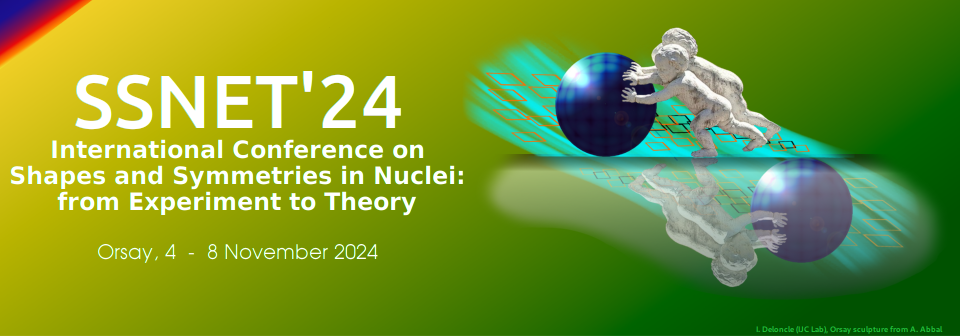Orateur
Description
Nuclei in the mass region 130 uniquely exhibit many different shapes and underlying symmetries, and have drawn considerable research interest. In $^{127}$I, we studied the phenomenon of shape coexistence at low excitation energy, and band termination at higher energy. Interestingly, the collective feature ceases at band termination due to rapid nuclear rotation and particle alignment. A pattern of irregular single-particle levels develops with the rotation of oblate shaped nuclei around the symmetry axis. Similar research works exist in literature for $^{121, 123, 125}$I [1, 2] as well. In our study, the reduced transition probabilities B(M1) and B(E2) are the crucial observables, obtained from the lifetime measurement in ps-fs range using the Doppler shift attenuation method (DSAM).
The high spin states of $^{127}$I were populated via the fusion-evaporation reaction $^{124}$Sn($^7$Li, 4n)$^{127}$I at the beam energy of 50 MeV delivered by the 15UD Pelletron accelerator at the Inter University Accelerator (New Delhi, India). The de-exciting $\gamma$-rays were detected by the Indian National Gamma Array consisting of 15 Compton suppressed clover detectors placed at 32$^{\circ}$, 57$^{\circ}$, 90$^{\circ}$, 123$^{\circ}$, and 148$^{\circ}$ with respect to the beam direction. The list mode data were sorted offline into angle-dependent asymmetric E$_{\gamma}$-E$_{\gamma}$ matrices to extract lifetimes. The details of DSAM-lineshape analysis are described in our earlier works [3, 4].
The latest research on $^{127}$I by Ding et al [5] has investigated many bands. But, our present study of lifetime measurement using DSAM is entirely new. Moreover, we have extended the negative-parity band based on $\pi$h$_{11/2}$ to higher spins up to band termination. At low spins, the band shows a sequence of E2 transitions which is a typical of near prolate-shaped nuclei. The theoretical results based on total Routhian surface (TRS) calculation predicted $\gamma$-softness ($\beta$ $\approx$ 0.2, $\gamma$ = 8$^{\circ}$-30$^{\circ}$ in Lund convention) below the particle alignment. When the band terminates, the shape becomes nearly oblate ($\beta$ $\approx$ 0.2, $\gamma$ $\approx$ 55$^{\circ}$). Our experimental result on B(E2) lies within 0.4 - 0.6 e$^2$b$^2$ for low spins with a sharp increase at 23/2$^-$ (2.7 e$^2$b$^2$) due to particle alignment. At high spin 27/2$^-$, the B(E2) value becomes low (0.07 e$^2$b$^2$). We estimated the B(E2) values using particle rotor model (PRM) and obtained a good comparison with the experimental results. Furthermore, this band shows a strong decoupling behaviour in comparison to the ground band of $^{126}$Te. The yrast positive-parity band was identified predominantly as $\pi$g$_{7/2}$ admixed with d$_{5/2}$. The band shows signature splitting and inversion at 17/2$^+$. The experimental B(E2) values remain roughly constant 0.47 e$^2$b$^2$ up to the signature inversion, and it abruptly decreases to 0.15 e$^2$b$^2$ at 19/2$^+$. The nuclei are triaxial ($\beta$ $\approx$ 0.23, $\gamma$ = 30$^{\circ}$) as predicted by TRS and confirmed by the PRM.
In summary, we have performed an exhaustive spectroscopic investigation for $^{127}$I, and inferred the coexistence of near prolate and triaxial shapes at low spins; while, an oblate structure emerges at high spins due to band termination.
References
[1] D. L. Balabanski et al., Phys. Rev. C 56 (1997) 1629.
[2] C. B. Moon and T. Komatsubara, J. Korean Phys. Soc. 45 (2004) L791.
[3] H. K. Singh et al., Phys. Rev. C 100 (2019) 064306.
[4] U. Lamani et al., Nucl. Phys. A 1014 (2021) 122220.
[5] B. Ding et al., Phys. Rev. C. 85 (2012) 044306.

